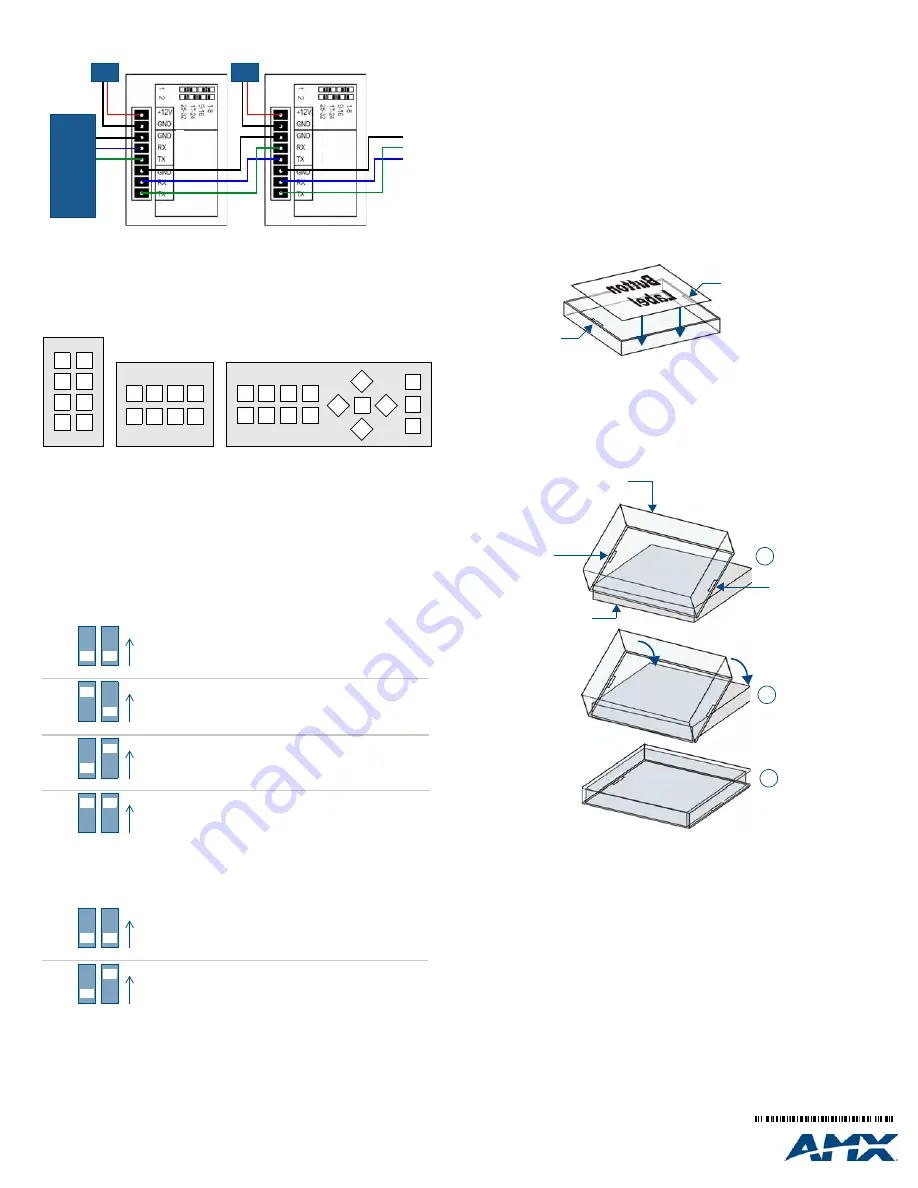
For full warranty information, refer to the AMX Instruction Manual(s) associated with your Product(s).
7/08
©2008 AMX. All rights reserved. AMX and the AMX logo are registered trademarks of AMX.
AMX reserves the right to alter specifications without notice at any time.
3000 RESEARCH DRIVE, RICHARDSON, TX 75082 • 800.222.0193 • fax 469.624.7153 • technical support 800.932.6993 • www.amx.com
93-1310-01
REV: B
Daisy-Chaining KeyPads
KeyPads can be daisy-chained as shown in FIG. 4.
•
Use screened cable to link units.
•
Maximum cable length between panels should not exceed 50’ (15.24 m).
Button Layout
FIG. 5 indicates the button layout for 8 and 16 button KeyPads:
•
8-Button KeyPads can be configured for button numbers 1-8, 9-16, 17-24, or
25-32.
•
16-Button KeyPads can be configured for button numbers 1-16 or 17-32.
Setting DIP Switches to Assign Alternate Button Numbering
Use the 2-position DIP Switch on the rear panel of the KeyPads to specify alternate
button numbers for each KeyPad, for cases in which you want to avoid having
multiple KeyPads in the same system using the same button numbers.
Note
: Multiple KeyPads are allowed to share identical button numbers.
Alternate Button Numbering: 8-Button KeyPads
The DIP Switch settings for 8-button KeyPads are described in FIG. 6:
Alternate Button Numbering: 16-Button KeyPads
The DIP Switch settings for 16-button KeyPads are described in FIG. 7:
Button Labelling
NOVARA ControlPads and KeyPads come with a set of clear plastic Key Caps,
which are designed to fit tightly over the pushbuttons, and allow you to place a label
on each button according to the requirements of your particular installation.
NOVARA ControlPads and KeyPads also come with a pre-printed acetate sheet with
a range of 50 (pre-cut) button label inserts. The button labels provided will
accommodate most installations, but it is also possible to print your own button labels
on acetate for custom button labelling.
Installing Acetate Button Labels and Key Caps - READ THIS FIRST!
1.
Punch out the desired Button Label from the included acetate sheet.
If you have printed your own custom button labels on acetate, cut each button
label to fit inside the Key Caps.
•
Custom button labels must be cut to a
1.20cm (0.472") square
to fit securely
inside the Key Caps.
•
The thickness of the acetate used must not exceed
.004”
(
0.10 mm).
2.
Place the Key Cap face-down, and insert the Button Label into the bottom of
the Key Cap (FIG. 8).
•
Orient the Button Label inside the Key Cap so that the two clips are located on
the left and right sides of the readable text on the Button Label, as indicated in
FIG. 8.
•
Be sure to place the Button Label face-down inside the Key Cap (see FIG. 8),
otherwise the label will be seen in reverse once the Key Cap is installed.
3.
Install the Key Cap on the pushbutton (FIG. 9):
Note
: Verify that the vertical orientation of the Button Label is correct relative to the
keypad.
a. Gently press the bottom of the Key Cap (no clip) onto the pushbutton.
Do not allow the clips on either side to engage
.
b. With the bottom of the Key Cap secured, gently press the top of the Key
Cap. This action will engage both clips simultaneously, and the Key Cap
will snap into place on the push button.
Note
: Be careful to follow these procedures closely - the bottom of the Key Cap must
be installed on the pushbutton before the Key Cap clips engage, or there is a risk of
the button being misaligned.
Removing the Key Caps requires additional steps - refer to the NOVARA
ControlPads Operation/Reference Guide for details on Replacing Button Labels/Key
Caps.
Additional Documentation
Refer to the
NOVARA ControlPads Operation/Reference Guide
(available at
www.amx.com) for additional installation details, configuration and RS232 control
instructions.
FIG. 4
Daisy-Chaining KeyPads
FIG. 5
KeyPads Button Layout
FIG. 6
DIP Switch Settings - Alternate Button Numbering: 8-Button KeyPads
FIG. 7
DIP Switch Settings - Alternate Button Numbering: 16-Button KeyPads
Power Supply
NetLinx Master
(RS232 port)
GND
TX
RX
Power Supply
TO
C
ONT
RO
LPA
D
TO
S
ATE
LLIT
E
TO
C
ONT
RO
LPA
D
TO
S
ATE
LLIT
E
1
2
3
4
5
6
7
8
15
13
14
12
16
9
10
11
1
2
3
4
5
6
7
8
1
2
3
4
5
6
7
8
1
2
ON
1-8
9-16
17-24
25-32
1
2
ON
1
2
ON
1
2
ON
Switch 1-down / Switch 2-down = Buttons 1-8
Switch 1-up / Switch 2-down = Buttons 9-16
Switch 1-down / Switch 2-up = Buttons 17-24
Switch 1-up / Switch 2-up = Buttons 25-32
1
2
ON
1-16
17-32
1
2
ON
Switch 1-down / Switch 2-down = Buttons 1-16
Switch 1-down / Switch 2-up = Buttons 17-32
FIG. 8
Placing a Button Label inside a Key Cap
FIG. 9
Placing a Button Label inside a Key Cap
Acetate Button Label
Key Cap (face-down)
Clip
Clip
(face down)
Clip
Clip
Pushbutton on keypad
Key Cap
- tilted so that the bottom
of the Cap is placed on the bottom
of the pushbutton first
At this point, do not allow the clips
on the sides of the Key Cap to engage
Press the top of the Key Cap
down to engage both clips at
once, securing the Key Cap
to the pushbutton
Once the clips are engaged,
the Key Cap is secured
to the pushbutton
1
2
3


